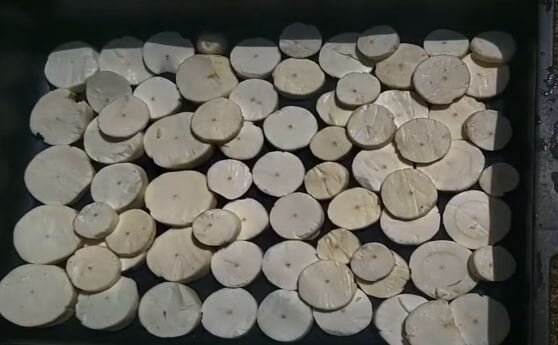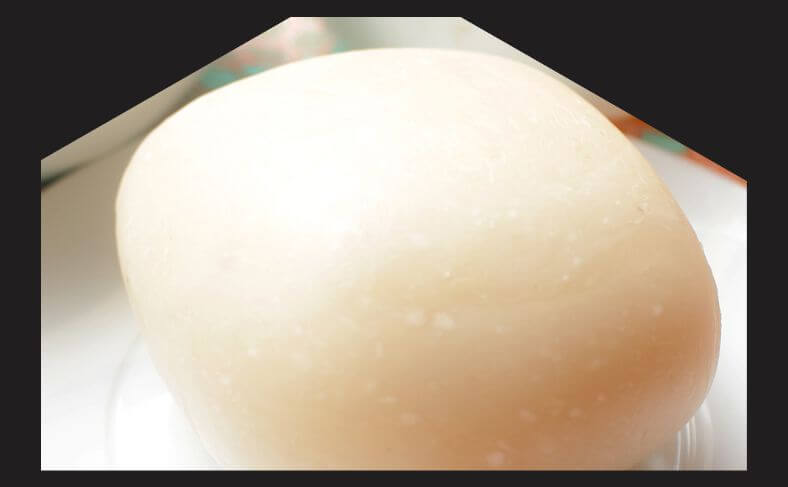Fufu, also (akpu, foufou, foofoo) is a cassava food swallowed with soup in West Africa. A heavy, starchy, filling side dish that delivers energy in one fell swoop, and it’s easy to make.
You can never go wrong with cassava fufu, also known as akpu, as you are sure to receive more than enough dose of energy for any physical task.
Made from the root of the cassava crop, fufu is a delight to behold.
This is one of the reasons why it is revered in many African countries, along with other cassava food products, particularly in West Africa, especially in Nigeria.
Fufu is known by many other names, like foufou, foutou, moteke, akpu, cou-cou, fungee, and these are going to be used throughout this article.
In this article, we will take a close look at this cassava product – its characteristics, how it is prepared, nutritional facts, and other information you would want to know.
Related: Fufu and Cassava Leaves: The Perfect Combo
Table of Contents
- What is Fufu (Akpu)?
- Brief History of Foufou
- Nutritional Benefits of Fufu
- Variations of Fufu by Region
- Fermentation – Local Method of Preparing Fufu (Foufou)
- Modern Way of Preparing Fufu (Foufou)
- Serving and Pairing Foofoo
- Frequently Asked Questions
- Final Word from Cassava Pathway
What is Fufu (Akpu)?
Fufu is a sticky, doughy dish made either by pounding fermented, cooked cassava roots, or stir-cooking grated cassava roots and eaten with stew or soup.
Though fufu was predominantly made from cassava, the definition has expanded over centuries as there have been variations with cocoyam, yam, potato, and plantain.
Brief History of Foufou
Fufu, a staple food in West Africa, has a rich history dating back to the Akan people of Ghana. The name originates from the Twi language, spoken by the Akan people.
It is made from boiled and pounded starchy cassava roots to be eaten by moulding it into morsels and dipping into spicy soups or stews..
The dish is believed to have originated in Ghana, where it is a staple food. It is prepared in various ways, with different regions contributing their unique techniques.
It is often served with soups or stews and is a symbol of unity and togetherness, strengthening bonds among family and friends.
Foufou, just like garri or cassava flakes, has been a lifesaver for the people of West Africa as it is easy to cultivate and does not take much to prepare.
Recommended: Pondu Cassava Leaves: The Congolese Delicacy
Nutritional Benefits of Fufu
While there are variations of this cassava dough, considering the ingredients, we will concentrate on the cassava variation since cassava is the focus of this website.
The nutritional value hinges on the nutritional content of cassava, which is the parent raw material.
Let’s take a closer look:
Macronutrients
Foufou is primarily composed of carbohydrates, which provide the body with energy, approximately 267 kcal (1118 kJ) per 100 g serving.
A single serving contains approximately 76.3 grams of carbohydrates, accounting for about 28% of the daily recommended intake.
Additionally, it is low in fat, with only 6.4 grams per serving, and contains negligible amounts of protein.
Fiber and Digestive Health of Foofoo
Just like its sister dish, garri, akpu is an excellent source of dietary fiber, containing 6.7 grams per serving.
This fiber content plays an important role in maintaining digestive health by promoting regular bowel movements and preventing constipation.
The fiber also acts as a prebiotic, supporting the growth of beneficial gut bacteria and enhancing overall gut health.
Vitamins and Minerals in Foufou
Foufou is rich in various vitamins and minerals, including:
- Vitamin C: It is a significant source of vitamin C, with 32.2 milligrams per serving. Vitamin C is essential for immune function and overall health.
- Potassium: Akpu contains 1096.8 milligrams of potassium per serving, which helps regulate blood pressure and supports overall cardiovascular health.
- Manganese: It is a good source of manganese, an essential mineral involved in enzyme function and antioxidant defenses.
Other Nutritional Benefits
Low Sodium: Foufou is naturally low in sodium, making it an excellent choice for individuals seeking to reduce their sodium intake.
Gluten-Free: It is gluten-free, making it suitable for individuals with gluten intolerance or those following a gluten-free diet.
Versatile: It can be served with a variety of soups, stews, and sauces, making it a versatile dish that can be customized to suit different tastes and preferences.
Related: Benefits of Mandioca
Variations of Fufu by Region
This cassava meal transcends regional boundaries, with countless variations found across Africa and the Caribbean. Let’s take a look at some of its variations across Africa and the Caribbean.
West African Varieties of Foofoo
In West Africa, the heartland of this cassava meal, the preparation and ingredients can vary significantly between countries and even within regions.
Ghanaian Fufu: A classic Ghanaian fufu is made by boiling and pounding a combination of cassava and plantains into a smooth, dough-like consistency. It is often served with groundnut or palm nut soup.
Nigerian Fufu (Akpu): Nigerian fufu, known as akpu, ụtara, loi-loi, or white swallow, is made from either fermented or grated cassava. Akpu gotten from fermented cassava has a rather uncomfortable aroma for many, while that gotten from grated cassava has the normal cassava aroma.
Ivorian (Foutou): In Côte d’Ivoire, fufu is called foutou and is typically made from boiled and pounded plantains or a mixture of plantains and cassava.
Central African Varieties
Foufou also has a strong presence in Central Africa, with variations that reflect the region’s diverse culinary traditions.
Congolese (Fufú, Moteke, Luku): In the Democratic Republic of the Congo and the Republic of the Congo, it goes by several names, including fufú, moteke, and luku. It is often made from boiled and pounded cassava or plantains.
Cameroonian (Couscous): In Cameroon, it is sometimes referred to as couscous and is commonly made from yams or cassava, served with a soup called njama njama or a spicy fish stew.
Caribbean Foofoo Varieties
The influence of West African cuisine can be seen in the fufu dishes of the Caribbean, where the dish has been adapted to local ingredients and culinary traditions.
Let’s take a closer look:
Haitian Fufu (Tomtom): In Haiti, the cassava meal is known as tomtom and is made from boiled and pounded green plantains or breadfruit, often served with a meat or vegetable stew.
Antiguan (Fungi/Fungee): In Antigua, it is called fungi or fungee and is made with cornmeal and okra, rather than the traditional root vegetables.
Barbadian (Cou-Cou): In Barbados, it is called cou-cou and is made with cornmeal or, less commonly, split peas, green bananas, or breadfruit.
The diversity of this cassava derivative across Africa and the Caribbean is a testament to the dish’s adaptability and the rich culinary heritage of these regions.
Whether it’s the tangy Nigerian akpu, the hearty Ghanaian variation, or the unique Antiguan fungi, each offers a delightful peek into the vibrant food cultures that have shaped this enduring staple.
There are two methods of preparing the cassava fufu in the Eastern region of Nigeria, which I also use.
The traditional (fermentation) and the modern (grating) methods.
Related: History of the Cassava Plant
Fermentation – Local Method of Preparing Fufu (Foufou)

The traditional or local methods of preparing foofoo is by fermentation, divided into the peeled and the unpeeled fermentation methods.
The peeled fermentation is when the cassava root is peeled before soaking for fermentation.
The unpeeled fermentation is when the cassava root is fermented with the back on (without peeling).
The effect is that most times, the end product of the peeled fermentation has a normal aroma, while that of unpeeled fermentation has a somewhat foul smell that is unpleasant to many.
That said, let’s get ahead.
Generally, fermentation is achieved by cutting the cassava roots into desirable sizes and soaking them in a water-filled container with a lid.
The soaking has to be between 3 to 5 days with intermittent closing and opening of the lid to let the fermentation gas take place.
The fermentation is to decompose the cassava halfway to soften the root and also to remove toxicity so it can be safe for consumption.
After 5 days of fermentation, the now very soft roots are retrieved, rinsed, sieved with special sieving equipment, and immersed in water.
The sieve is to make the desired product as fine as possible.
The sieving leaves a pasty consistency, which is now put in a special pot and cooked while stirring throughout until a dough-like consistency, which is fufu is achieved.
Related: Is Cassava a Good Meal for You?
Modern Way of Preparing Fufu (Foufou)
The modern method of preparing foufou is rather quick and straightforward. However, it is important to note that this method does not entirely remove the toxicity from the cassava roots.
Preparing fufu in this way is achieved by peeling, washing and cutting the roots into bite-sized pieces.
After blending, it is then cooked while stirring consistently like the fermented method above until the turns into a well-cooked akpu.
The advantage of this method is that it is quick and does not have a foul smell.
Serving and Pairing Foofoo
Foufou is served and paired mostly with any kind of Nigerian soup. When in a restaurant and want soup as your meal, you order your soup and choose between garri or foufou to go with it.
However, in some other African countries like Ghana, it is served with either soup or stews.
Frequently Asked Questions
What is fufu made out of?
It is traditionally made from cassava and green plantains.
Is fufu Nigerian or Ghana?
It is a staple food in both Nigeria and Ghana, as well as other West African countries.
What is the English name of fufu?
The cassava meal does not have any English name.
How healthy is fufu?
It is a starchy, carbohydrate-rich food, but can be part of a balanced diet when consumed in moderation as part of a varied meal.
Final Word from Cassava Pathway
Fufu is predominantly a West African dish from cassava, prepared by turning it into a dough and swallowed with soup or stew.
Its high carbohydrate and fiber content make it an excellent choice for those seeking a filling and nutritious meal.
Additionally, its low fat and sodium content, as well as its rich source of vitamins and minerals, make it an excellent addition to a well-balanced diet.
Citations:
https://www.okayafrica.com/what-is-fufu-a-quick-guide-to-africas-staple-food
https://mysasun.com/blogs/bloglearning-bytes/discovering-10-fufu-swallow-variants-in-africa

Chimeremeze Emeh is a writer and researcher passionate about Africa’s most transformative root crop—cassava. Through his work at cassavavaluechain.com, he explores the entire cassava industry, from cultivation and processing to its diverse applications in food, health, and industrial use.
He also writes for palmoilpalm.com, where he shares his extensive experience and deep-rooted knowledge of palm oil, covering red palm oil, palm kernel oil, and refined products. His work there reflects his lifelong connection to agriculture and his commitment to promoting sustainable value chains in Africa.
Driven by curiosity and purpose, Chimeremeze aims to shed light on how cassava continues to empower communities, strengthen food systems, and link traditional farming wisdom with modern innovation.

